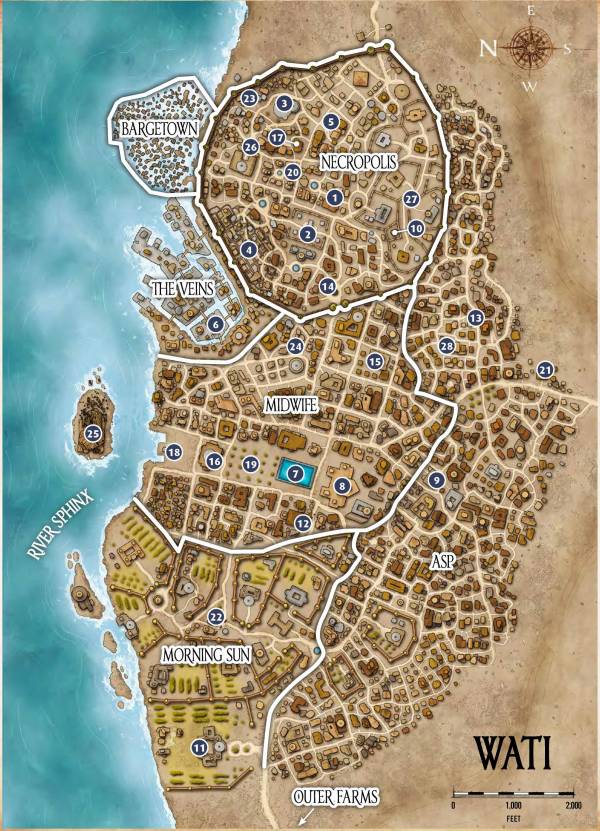User Tools
Sidebar
Table of Contents
The City of Wati
History
The City of Wati sits on a sandstone shelf at the confluence of the Asp and Crook rivers which provide it with building materials, rich farmland, and deep harbors sufficient to support a settlement three times its size. But even with its tenacious citizens, abundant fish and game, and thriving marketplaces fueled by the most important rivers in Osirion, Wati is forever a city better known for its dead than for its living. Behind sanctified walls, an entire quarter ofthe city quietly sits as a massive, urban tomb. Shops, schools, markets, and estates serve as eternal resting places for those lost to madness and disease. To manage such an immense project, the city's entire economy shifted to the industry ofinterment. Almost i,800 years after the necropolis's inception, many of Wati's residents continue to serve the city's funeral industry, either directly as embalmers, undertakers, and clerics of Pharasma, or indirectly by crafting the myriad grave goods all Osirians hope to carry with them into the afterlife. Death has become the city's lifeblood, and Wati prospers from its morbid specialty.
In -1608 AR, Pharaoh Djederet II ordered the construction of a grand city to mark the birthplace of the Osirion's greatest natural resource: the River Sphinx, springing from the confluence of the Asp and the Crook. With its early foundations magically laid by the church ofNethys, the city sprang to life within just a year. Named Wati, the riverside town soon dominated trade across southern Osirion. Hardwoods and spices from Katapesh and the Mwangi Expanse bound for Sothis, and manufactured goods and luxuries from the nations surrounding the Inner Sea bound for Osirion's southern territories, all paused long enough in Wati's warehouses and markets to make its citizens famously wealthy. For centuries, Wati endured through political upheaval and the births and deaths of entire dynasties as it dominated its younger sister cities ofAn and Tephu
But Wati's destiny was forever warped in 2499 AR, when the cult of Lamashtu unleashed the Plague of Madness among the city's thriving populace. Many of those whom the fever did not immediately kill were driven to murderous insanity, and within months, more than half the city had fallen in painful, anguished death. Most of the survivors fled Wati to make new homes elsewhere, but a stubborn minority remained behind, determined to reclaim their city. But even once the plague had run its course, their livelihoods collapsed as An and Tephu took overWati's onceexclusive trade routes, and their floundering community struggled against recurring outbreaks ofthe undead from the city's many abandoned buildings-turned-tombs
It took almost halfa millennium for Wati's fortunes to reverse thanks to the church of Pharasma. With the tacit perm1ss10n of Osirion's Keleshite sultan, a Pharasmin priest named Nefru Shepses marched on Wati in 2953 AR with a small army ofalchemists, masons, and morticians under his banner, intent on consecrating the entire city to the Lady ofGraves, beginning with a new, monumental temple to Pharasma called the Grand Mausoleum. Over the next 30 years, Nefru Shepses and his followers recovered the bodies of those slaughtered in the Plague of Madness from their hasty, makeshift graves and the Pharasmins walled off that portion of the city that had been abandoned, transforming it into a metropolis of makeshift tombs. Thousands ofcorpses were given formal burial rites and reinterred in this dead copy ofthe living city, which continues to serve as Wati's necropolis today.
The consecration ofthe city and its necropolis revitalized Wati, and though it never reclaimed its dominance among the cities ofthe south, over the next 1,700 years Wati grew until its necropolis-once more than half of the citytook up less than a quarter ofthe city's total area. Today, long after the necropolis's completion, Wati continues to produce a great variety of grave goods for Osirion's honored dead. A steady stream ofburial figures, canopic jars, embalming fluids, prayer books, and sarcophagi sail downstream on the Sphinx, outpacing Wati's crop and textile exports. Even Wati's criminal underworld revolves around death, as competing gangs regularly raid the necropolis for valuables and even human carrion.

